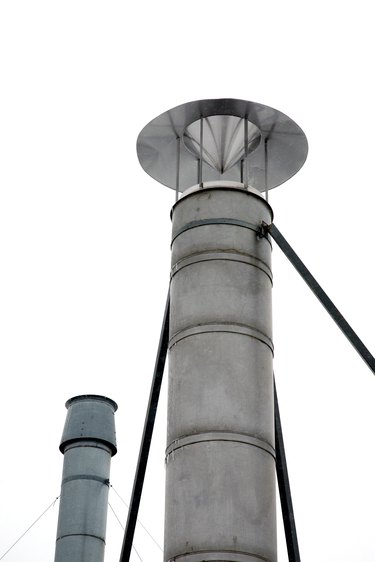
Chimneys carry smoke and soot from a fireplace or furnace out of the house. Wood-burning stoves and fireplaces produce more smoke than clean-burning gas furnaces, but both require venting through a chimney or stovepipe. The top of a chimney after installation does not always have a chimney cap. You will likely need to install a cap for your gas furnace chimney, but not for the reasons you might think.
Chimney Caps
Video of the Day
Chimney caps fit on top of the chimney to provide ventilation of the chimney as well as a block against water and animals. According to Carson Dunlop & Associates in "Essentials of Home Inspection: Home Reference Book," the best chimney caps extend at least 1 inch over the edges of the chimney so water does not drip off the edge of the cap and into the chimney. Look for chimney caps that only cover the top edges of the chimney or are suspended above the flue opening at the top of the chimney. No matter the type of chimney cap you install, it must be removable for regular cleaning and servicing of the chimney.
Video of the Day
Rain Guard
Chimney caps keep rain off the masonry sides of chimneys. Rain falling on the masonry over time can wear it away. A chimney cap made of concrete or metal fits around exposed masonry to protect it from this, but it does not cover the flue. Rain caps are another type of chimney cap. These cover the top of the flue to keep water from flowing down the flue.
Animal Block
Animals such as birds or rodents look for small, enclosed spaces to build their nests. When viewed from above, a chimney opening resembles a hole in a tree. To bird-brained animals, the difference between your chimney and a tree is not apparent, especially during the warmer months when your chimney is out of use. Nesting animals in your chimney cause blockages that result in carbon monoxide from your gas furnace backing up into your home. This dangerous situation can be prevented by installing a chimney cap that is suspended over the flue to let gas out and keep animals out.
Downdraft
Strong winds blowing across the top of uncapped chimneys can blow the gases from the furnace back down the chimney, inadequately venting the furnace. A wind or rain cap creates a partial barrier to the wind so its effects are lessened. This type of cap covers the top of a chimney, differing from the concrete chimney cap surrounding the masonry at the top of the chimney.